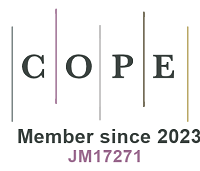REFERENCES
1. Frias, J. P. G. L.; Nash, R. Microplastics: Finding a consensus on the definition. Mar. Pollut. Bull. 2019, 138, 145-7.
2. Wu, P.; Huang, J.; Zheng, Y.; et al. Environmental occurrences, fate, and impacts of microplastics. Ecotoxicol. Environ. Saf. 2019, 184, 109612.
3. Ziajahromi, S.; Leusch, F. D. L. Systematic assessment of data quality and quality assurance/quality control (QA/QC) of current research on microplastics in biosolids and agricultural soils. Environ. Pollut. 2022, 294, 118629.
4. Ruffell, H.; Pantos, O.; Robinson, B.; Gaw, S. A method for the extraction of microplastics from solid biowastes including biosolids, compost, and soil for analysis by µ-FTIR. MethodsX 2024, 12, 102761.
5. Ragoobur, D.; Huerta-Lwanga, E.; Somaroo, G. D. Microplastics in agricultural soils, wastewater effluents and sewage sludge in Mauritius. Sci. Total. Environ. 2021, 798, 149326.
6. Pérez-Reverón, R.; González-Sálamo, J.; Hernández-Sánchez, C.; González-Pleiter, M.; Hernández-Borges, J.; Díaz-Peña, F. J. Recycled wastewater as a potential source of microplastics in irrigated soils from an arid-insular territory (Fuerteventura, Spain). Sci. Total. Environ. 2022, 817, 152830.
7. Ruffell, H.; Pantos, O.; Northcott, G.; Gaw, S. Wastewater treatment plant effluents in New Zealand are a significant source of microplastics to the environment. New. Zealand. Journal. of. Marine. and. Freshwater. Research. 2023, 57, 336-52.
8. Almroth BM, Åström L, Roslund S, Petersson H, Johansson M, Persson NK. Quantifying shedding of synthetic fibers from textiles; a source of microplastics released into the environment. Environ. Sci. Pollut. Res. Int. 2018, 25, 1191-9.
9. Kim, M. J.; Na, S. H.; Batool, R.; Byun, I. S.; Kim, E. J. Seasonal variation and spatial distribution of microplastics in tertiary wastewater treatment plant in South Korea. J. Hazard. Mater. 2022, 438, 129474.
10. Le, T.; Truong, T.; Nguyen, P.; et al. Evaluation of microplastic removal efficiency of wastewater-treatment plants in a developing country, Vietnam. Environmental. Technology. &. Innovation. 2023, 29, 102994.
11. Iyare, P. U.; Ouki, S. K.; Bond, T. Microplastics removal in wastewater treatment plants: a critical review. Environ. Sci. :. Water. Res. Technol. 2020, 6, 2664-75.
12. Sivarajah, B.; Lapen, D. R.; Gewurtz, S. B.; Smyth, S. A.; Provencher, J. F.; Vermaire, J. C. How many microplastic particles are present in Canadian biosolids? J. Environ. Qual. 2023, 52, 1037-48.
13. Bläsing, M.; Amelung, W. Plastics in soil: Analytical methods and possible sources. Sci. Total. Environ. 2018, 612, 422-35.
14. Ng, E. L.; Huerta, L. E.; Eldridge, S. M.; et al. An overview of microplastic and nanoplastic pollution in agroecosystems. Sci. Total. Environ. 2018, 627, 1377-88.
15. Soobhany, N.; Mohee, R.; Garg, V. K. Inactivation of bacterial pathogenic load in compost against vermicompost of organic solid waste aiming to achieve sanitation goals: a review. Waste. Manag. 2017, 64, 51-62.
16. Braun, M.; Mail, M.; Heyse, R.; Amelung, W. Plastic in compost: prevalence and potential input into agricultural and horticultural soils. Sci. Total. Environ. 2021, 760, 143335.
17. Sholokhova, A.; Ceponkus, J.; Sablinskas, V.; Denafas, G. Abundance and characteristics of microplastics in treated organic wastes of Kaunas and Alytus regional waste management centres, Lithuania. Environ. Sci. Pollut. Res. Int. 2022, 29, 20665-74.
18. Nazareth, M. C.; Marques, M. R. C.; Pinheiro, L. M.; Castro, Í. B. Key issues for bio-based, biodegradable and compostable plastics governance. J. Environ. Manage. 2022, 322, 116074.
19. Marchuk, S.; Tait, S.; Sinha, P.; Harris, P.; Antille, D. L.; McCabe, B. K. Biosolids-derived fertilisers: A review of challenges and opportunities. Sci. Total. Environ. 2023, 875, 162555.
20. Sardarmehni, M.; Levis, J. W.; Barlaz, M. A. What is the best end use for compost derived from the organic fraction of municipal solid waste? Environ. Sci. Technol. 2021, 55, 73-81.
21. Horrocks, A.; Curtin, D.; Tregurtha, C.; Meenken, E. Municipal compost as a nutrient source for organic crop production in New Zealand. Agronomy 2016, 6, 35.
22. Gutiérrez-Ginés, M. J.; Robinson, B. H.; Esperschuetz, J.; Madejón, E.; Horswell, J.; McLenaghen, R. Potential use of biosolids to reforest degraded areas with New Zealand native vegetation. J. Environ. Qual. 2017, 46, 906-14.
23. Scharenbroch, B. C.; Meza, E. N.; Catania, M.; Fite, K. Biochar and biosolids increase tree growth and improve soil quality for urban landscapes. J. Environ. Qual. 2013, 42, 1372-85.
24. Milinković, M.; Lalević, B.; Jovičić-petrović, J.; Golubović-ćurguz, V.; Kljujev, I.; Raičević, V. Biopotential of compost and compost products derived from horticultural waste-effect on plant growth and plant pathogens' suppression. Process. Saf. Environ. Prot. 2019, 121, 299-306.
25. Arancon, N. Q.; Edwards, C. A.; Bierman, P.; Metzger, J. D.; Lucht, C. Effects of vermicomposts produced from cattle manure, food waste and paper waste on the growth and yield of peppers in the field. Pedobiologia 2005, 49, 297-306.
26. Lin, D.; Yang, G.; Dou, P.; et al. Microplastics negatively affect soil fauna but stimulate microbial activity: insights from a field-based microplastic addition experiment. Proc. Biol. Sci. 2020, 287, 20201268.
27. Colzi, I.; Renna, L.; Bianchi, E.; et al. Impact of microplastics on growth, photosynthesis and essential elements in cucurbita pepo L. J. Hazard. Mater. 2022, 423, 127238.
28. Lee, T. Y.; Kim, L.; Kim, D.; An, S.; An, Y. J. Microplastics from shoe sole fragments cause oxidative stress in a plant (vigna radiata) and impair soil environment. J. Hazard. Mater. 2022, 429, 128306.
29. Lahive, E.; Walton, A.; Horton, A. A.; Spurgeon, D. J.; Svendsen, C. Microplastic particles reduce reproduction in the terrestrial worm enchytraeus crypticus in a soil exposure. Environ. Pollut. 2019, 255, 113174.
30. Gao, B.; Yao, H.; Li, Y.; Zhu, Y. Microplastic addition alters the microbial community structure and stimulates soil carbon dioxide emissions in vegetable‐growing soil. Environ. Toxicol. Chem. 2021, 40, 352-65.
31. Huang, Y.; Zhao, Y.; Wang, J.; Zhang, M.; Jia, W.; Qin, X. LDPE microplastic films alter microbial community composition and enzymatic activities in soil. Environ. Pollut. 2019, 254, 112983.
32. Cui, G.; Lü, F.; Hu, T.; Zhang, H.; Shao, L.; He, P. Vermicomposting leads to more abundant microplastics in the municipal excess sludge. Chemosphere 2022, 307, 136042.
33. Masura, J.; Baker, J.; Foster, G.; Arthur, C. Laboratory methods for the analysis of microplastics in the marine environment: recommendations for quantifying synthetic particles in waters and sediments. In: Herring C, editor. NOAA: National Oceanic and Atmospheric Administration 2015.
34. Coppock, R. L.; Cole, M.; Lindeque, P. K.; Queirós, A. M.; Galloway, T. S. A small-scale, portable method for extracting microplastics from marine sediments. Environ. Pollut. 2017, 230, 829-37.
35. Rochman, C. M.; Brookson, C.; Bikker, J.; et al. Rethinking microplastics as a diverse contaminant suite. Environ. Toxicol. Chem. 2019, 38, 703-11.
36. New Zealand Water & Wastes Association (NZWWA). Guidelines for the safe application of biosolids to land in New Zealand. Wellington; 2003. Available from: https://www.waternz.org.nz/Folder?Action=View%20File&Folder_id=101&File=biosolids_guidelines.pdf. [Last accessed on 23 Dec 2024].
37. Li, X.; Chen, L.; Mei, Q.; et al. Microplastics in sewage sludge from the wastewater treatment plants in China. Water. Res. 2018, 142, 75-85.
38. Gies, E. A.; LeNoble, J. L.; Noël, M.; et al. Retention of microplastics in a major secondary wastewater treatment plant in Vancouver, Canada. Mar. Pollut. Bull. 2018, 133, 553-61.
39. Meng, K.; Lwanga, E. H.; van, Z. M.; Munhoz, D. R.; Geissen, V. Fragmentation and depolymerization of microplastics in the earthworm gut: a potential for microplastic bioremediation? J. Hazard. Mater. 2023, 447, 130765.
40. Kwak, J. I.; An, Y. J. Microplastic digestion generates fragmented nanoplastics in soils and damages earthworm spermatogenesis and coelomocyte viability. J. Hazard. Mater. 2021, 402, 124034.
41. Zhang, S.; Li, Y.; Chen, X.; et al. Occurrence and distribution of microplastics in organic fertilizers in China. Sci. Total. Environ. 2022, 844, 157061.
42. Schothorst B, Beriot N, Huerta Lwanga E, Geissen V. Sources of light density microplastic related to two agricultural practices: the use of compost and plastic mulch. Environments 2021, 8, 36.
43. Gui, J.; Sun, Y.; Wang, J.; Chen, X.; Zhang, S.; Wu, D. Microplastics in composting of rural domestic waste: abundance, characteristics, and release from the surface of macroplastics. Environ. Pollut. 2021, 274, 116553.
44. Zafiu, C.; Binner, E.; Beigl, P.; Vay, B.; Ebmer, J.; Huber-Humer, M. The dynamics of macro- and microplastic quantity and size changes during the composting process. Waste. Manag. 2023, 162, 18-26.
45. Napper, I. E.; Thompson, R. C. Release of synthetic microplastic plastic fibres from domestic washing machines: effects of fabric type and washing conditions. Mar. Pollut. Bull. 2016, 112, 39-45.
46. Anagnosti, L.; Varvaresou, A.; Pavlou, P.; Protopapa, E.; Carayanni, V. Worldwide actions against plastic pollution from microbeads and microplastics in cosmetics focusing on European policies. Has the issue been handled effectively? Mar. Pollut. Bull. 2021, 162, 111883.
47. Rochman, C. M.; Kross, S. M.; Armstrong, J. B.; et al. Scientific evidence supports a ban on microbeads. Environ. Sci. Technol. 2015, 49, 10759-61.
48. New Zealand Government Te Kāwanatanga o Aotearoa. Waste minimisation (microbeads) regulations 2017. Ministry for the environment. Wellington; 2017. Available from: https://www.legislation.govt.nz/regulation/public/2017/0291/latest/DLM7490715.html. [Last accessed on 23 Dec 2024].
49. Liu, X.; Yuan, W.; Di, M.; Li, Z.; Wang, J. Transfer and fate of microplastics during the conventional activated sludge process in one wastewater treatment plant of China. Chem. Eng. J. 2019, 362, 176-82.
50. Zhou, Q.; Zhang, H.; Fu, C.; et al. The distribution and morphology of microplastics in coastal soils adjacent to the Bohai Sea and the Yellow Sea. Geoderma 2018, 322, 201-8.
51. Raju, S.; Carbery, M.; Kuttykattil, A.; et al. Improved methodology to determine the fate and transport of microplastics in a secondary wastewater treatment plant. Water. Res. 2020, 173, 115549.
52. Tagg, A. S.; Ivar, S. J. A. Is this your glitter? An overlooked but potentially environmentally-valuable microplastic. Mar. Pollut. Bull. 2019, 146, 50-3.
53. Yurtsever, M. Tiny, shiny, and colorful microplastics: are regular glitters a significant source of microplastics? Mar. Pollut. Bull. 2019, 146, 678-82.
54. Pantos, O.; Masterton, H.; Ruffell, H. Sources of nanoplastic and microplastic pollution which are hidden in plain sight. Camb. prisms. Plast. 2024, 2, e25.
55. Renzi, M.; Blašković, A. Litter & microplastics features in table salts from marine origin: italian versus Croatian brands. Mar. Pollut. Bull. 2018, 135, 62-8.
56. Kunz, A.; Schneider, F.; Anthony, N.; Lin, H. T. Microplastics in rivers along an urban-rural gradient in an urban agglomeration: correlation with land use, potential sources and pathways. Environ. Pollut. 2023, 321, 121096.
57. Ehlers, S. M.; Ellrich, J. A.; Koop, J. H. E. Microplastic load and polymer type composition in European rocky intertidal snails: consistency across locations, wave exposure and years. Environ. Pollut. 2022, 292, 118280.
58. Courtene-Jones, W.; Burgevin, F.; Munns, L.; et al. Deterioration of bio-based polylactic acid plastic teabags under environmental conditions and their associated effects on earthworms. Sci. Total. Environ. 2024, 934, 172806.
59. Liao, J.; Chen, Q. Biodegradable plastics in the air and soil environment: low degradation rate and high microplastics formation. J. Hazard. Mater. 2021, 418, 126329.
60. Edo, C.; Fernández-Piñas, F.; Rosal, R. Microplastics identification and quantification in the composted organic fraction of municipal solid Waste. Sci. Total. Environ. 2022, 813, 151902.
61. Weithmann, N.; Möller, J. N.; Löder, M. G. J.; Piehl, S.; Laforsch, C.; Freitag, R. Organic fertilizer as a vehicle for the entry of microplastic into the environment. Sci. Adv. 2018, 4, eaap8060.
62. Harley-Nyang, D.; Memon, F. A.; Jones, N.; Galloway, T. Investigation and analysis of microplastics in sewage sludge and biosolids: a case study from one wastewater treatment works in the UK. Sci. Total. Environ. 2022, 823, 153735.
63. Magni, S.; Binelli, A.; Pittura, L.; et al. The fate of microplastics in an Italian wastewater treatment plant. Sci. Total. Environ. 2019, 652, 602-10.
64. Cattle, S. R.; Robinson, C.; Whatmuff, M. The character and distribution of physical contaminants found in soil previously treated with mixed waste organic outputs and garden waste compost. Waste. Manag. 2020, 101, 94-105.
65. Braun, M.; Mail, M.; Krupp, A. E.; Amelung, W. Microplastic contamination of soil: are input pathways by compost overridden by littering? Sci. Total. Environ. 2023, 855, 158889.
66. Watteau, F.; Dignac, M.; Bouchard, A.; Revallier, A.; Houot, S. Microplastic detection in soil amended with municipal solid waste composts as revealed by transmission electronic microscopy and pyrolysis/GC/MS. Front. Sustain. Food. Syst. 2018, 2, 81.
67. Tran, T. K. A.; Raju, S.; Singh, A.; et al. Occurrence and distribution of microplastics in long-term biosolid-applied rehabilitation land: an overlooked pathway for microplastic entry into terrestrial ecosystems in Australia. Environ. Pollut. 2023, 336, 122464.
68. Rashti M, Hintz J, Esfandbod M, Bahadori M, Lan Z, Chen C. Detecting microplastics in organic-rich materials and their potential risks to earthworms in agroecosystems. Waste. Manag. 2023, 166, 96-103.
69. Radford, F.; Horton, A.; Hudson, M.; Shaw, P.; Williams, I. Agricultural soils and microplastics: are biosolids the problem? Front. Soil. Sci. 2023, 2, 941837.
70. Heerey, L.; O'Sullivan, J. J.; Bruen, M.; et al. Export pathways of biosolid derived microplastics in soil systems - findings from a temperate maritime climate. Sci. Total. Environ. 2023, 888, 164028.
71. Zubris, K. A.; Richards, B. K. Synthetic fibers as an indicator of land application of sludge. Environ. Pollut. 2005, 138, 201-11.
72. Weber, C. J.; Santowski, A.; Chifflard, P. Investigating the dispersal of macro- and microplastics on agricultural fields 30 years after sewage sludge application. Sci. Rep. 2022, 12, 6401.
73. den Berg P, Huerta-Lwanga E, Corradini F, Geissen V. Sewage sludge application as a vehicle for microplastics in eastern spanish agricultural soils. Environ. Pollut. 2020, 261, 114198.
74. Crossman, J.; Hurley, R. R.; Futter, M.; Nizzetto, L. Transfer and transport of microplastics from biosolids to agricultural soils and the wider environment. Sci. Total. Environ. 2020, 724, 138334.
75. Corradini, F.; Meza, P.; Eguiluz, R.; Casado, F.; Huerta-Lwanga, E.; Geissen, V. Evidence of microplastic accumulation in agricultural soils from sewage sludge disposal. Sci. Total. Environ. 2019, 671, 411-20.
76. Rillig, M. C.; Ziersch, L.; Hempel, S. Microplastic transport in soil by earthworms. Sci. Rep. 2017, 7, 1362.
77. Li, J.; Song, Y.; Cai, Y. Focus topics on microplastics in soil: analytical methods, occurrence, transport, and ecological risks. Environ. Pollut. 2020, 257, 113570.
78. Lwanga, E. H.; Beriot, N.; Corradini, F.; et al. Review of microplastic sources, transport pathways and correlations with other soil stressors: a journey from agricultural sites into the environment. Chem. Biol. Technol. Agric. 2022, 9, 20.
79. Rezaei, M.; Abbasi, S.; Pourmahmood, H.; Oleszczuk, P.; Ritsema, C.; Turner, A. Microplastics in agricultural soils from a semi-arid region and their transport by wind erosion. Environ. Res. 2022, 212, 113213.
80. Han, N.; Zhao, Q.; Ao, H.; Hu, H.; Wu, C. Horizontal transport of macro- and microplastics on soil surface by rainfall induced surface runoff as affected by vegetations. Sci. Total. Environ. 2022, 831, 154989.
81. Beni N, Karimifard S, Gilley J, Messer T, Schmidt A, Bartelt-hunt S. Higher concentrations of microplastics in runoff from biosolid-amended croplands than manure-amended croplands. Commun. Earth. Environ. 2023, 4, 42.
82. Masterton, H.; Ruffell, H.; Gaw, S.; Pantos, O. The role of plastics in the accumulation and release of trace elements in the environment. Camb. prisms. Plast. 2023, 1, e15.
83. Liu, P.; Zhan, X.; Wu, X.; Li, J.; Wang, H.; Gao, S. Effect of weathering on environmental behavior of microplastics: properties, sorption and potential risks. Chemosphere 2020, 242, 125193.







